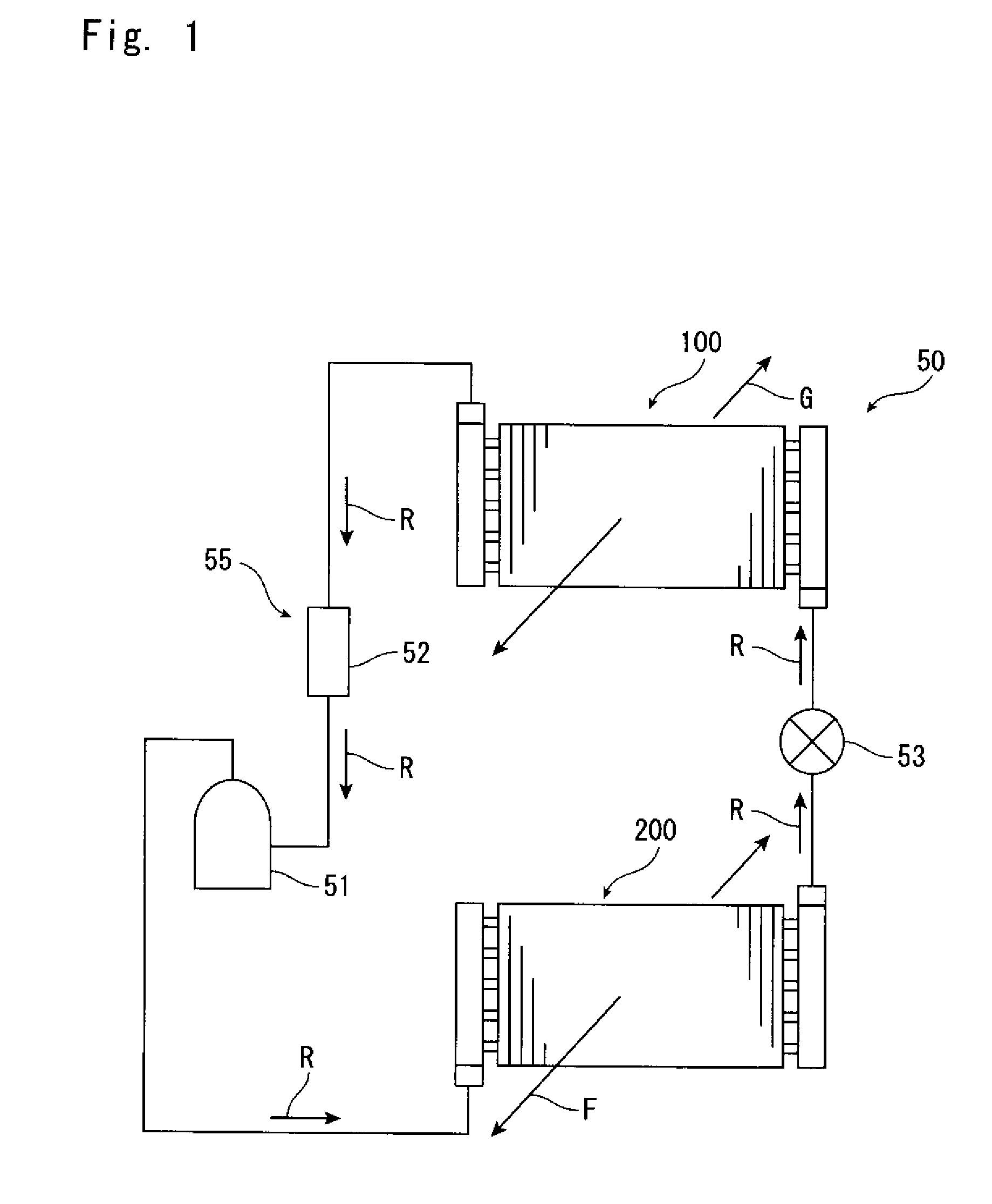Heat exchanger
a technology of heat exchanger and heat exchange medium, which is applied in the direction of refrigerating machines, lighting and heating apparatus, fluid circulation arrangement, etc., can solve the problems of non-uniform distribution of refrigerant into the plurality of heat exchange tubes, inconvenient use, and insufficient parts, etc., to achieve uniform distribution reduce separation of heat exchange medium, and simple construction
- Summary
- Abstract
- Description
- Claims
- Application Information
AI Technical Summary
Benefits of technology
Problems solved by technology
Method used
Image
Examples
first embodiment
[0028]FIG. 2 shows a heat exchanger 100a according to the present invention. This heat exchanger 100a can be used as the evaporator 100 of the system 50. The heat exchanger 100a includes an entrance header 1 that includes a refrigerant inlet 6, an exit header 2 that includes a refrigerant outlet 5, and a heat exchanging part 20. The entrance header 1 and the exit header 2 both extend in the up-down direction (vertical direction) and are disposed so as to be parallel to one another. The heat exchanging part 20 exchanges heat between the refrigerant R and the air G or the like so as to cool the air G or the like. The heat exchanging part 20 includes a plurality of tubes 4, which are disposed in parallel in the horizontal direction so as to fluidly connect the entrance header 1 and the exit header 2, and fins 3, which extend in the up-down direction so as to be perpendicular to the tubes 4.
[0029]A typical example of the tubes 4 are tubes that are circular in cross-section, but the tube...
second embodiment
[0038]FIG. 3 shows a heat exchanger 100b according to the present invention. This heat exchanger 100b can also be used as the evaporator 100 of the heat exchange system 50 described above. In the heat exchanger 100b, a plurality of tubes 4 are connected at substantially equal intervals to the return channel 10b of the circulating conduit 10 of the entrance header 1. In the circulating conduit 10 in which at least part of the in-flowed refrigerant R is forcibly circulated, the state of the refrigerant R becomes substantially uniformly mixed phase in not only the outward channel 10a but also the return channel 10b. Accordingly, it is possible to distribute the refrigerant R substantially uniformly to the respective tubes 4 when the tubes 4 are fluidly connected to the return channel 10b. In addition, at a position that is somewhat distant from the throat part 7, for example, at the return channel 10b, the phase state of the refrigerant R mixed by suction tends to be more stable or uni...
third embodiment
[0039]FIG. 4 shows a heat exchanger 100c according to the present invention. This heat exchanger 100c can also be used as the evaporator 100 of the heat exchange system 50 described above. In the heat exchanger 100c, the entrance header 1 includes a U-shaped tube that includes two straight parts, with such straight parts being fluidly connected at the open end of the U shape by the drawing channel 9. The entrance header 1 includes a circulating conduit (circulating pathway) 10 and both the outward channel 10a and the return channel 10b of the circulating conduit 10 are fluidly connected to the plurality of tubes 4. Accordingly, it is possible to supply the refrigerant R in a substantially uniform state to the plurality of tubes 4 that are aligned in two columns along the outward channel 10a and the return channel 10b. According to the heat exchanger 100c, it is possible to further increase the heat exchange efficiency of the heat exchanging part 20 without changing the surface area ...
PUM
 Login to View More
Login to View More Abstract
Description
Claims
Application Information
 Login to View More
Login to View More - R&D
- Intellectual Property
- Life Sciences
- Materials
- Tech Scout
- Unparalleled Data Quality
- Higher Quality Content
- 60% Fewer Hallucinations
Browse by: Latest US Patents, China's latest patents, Technical Efficacy Thesaurus, Application Domain, Technology Topic, Popular Technical Reports.
© 2025 PatSnap. All rights reserved.Legal|Privacy policy|Modern Slavery Act Transparency Statement|Sitemap|About US| Contact US: help@patsnap.com



